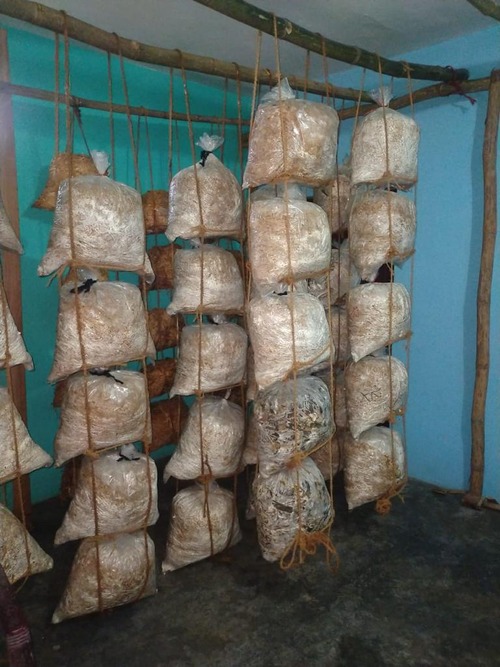Introduction:
Growing mushrooms at home is an art that not only promises a sustainable source of fresh and flavorful fungi but also offers a unique connection with the natural world. In this comprehensive guide, we will walk you through the process of cultivating six popular mushroom varieties right in the comfort of your home. Whether you are a seasoned gardener or a complete novice, this article will provide you with everything you need to know to succeed in mushroom cultivation.

Shiitake Mushrooms: A Delightful Culinary Adventure
Shiitake mushrooms have graced East Asian cuisine for centuries, prized for their exquisite taste and numerous health benefits.
To cultivate shiitake mushrooms at home, you’ll need to create a substrate using hardwood logs or sawdust. After inoculating the substrate with shiitake spawn, it is crucial to keep the logs in a cool, shady place and maintain regular misting.
The result of your patience and care will be a bountiful harvest of delectable shiitake mushrooms that will elevate your culinary creations to new heights.
Oyster Mushrooms: The Ideal Starting Point
For those new to mushroom cultivation, oyster mushrooms are a perfect introduction. These delicate fungi are renowned for their rapid growth and adaptability to various environments.
Oyster mushrooms can be cultivated on a range of substrates, from straw to coffee grounds or even old newspapers. Their versatility makes them a popular choice for home growers, and within a few weeks of inoculation, you’ll be rewarded with a flavorful harvest of oyster mushrooms to enjoy in your favorite dishes.
Portobello Mushrooms: A Gourmet Choice
With their rich, meaty flavor and substantial size, Portobello mushrooms have become a gourmet favorite.
Cultivating these mushrooms at home requires a compost-based substrate enriched with essential nutrients. After inoculating the substrate with mushroom spawn, maintaining a consistently moist environment with adequate ventilation is crucial.
Witness the captivating transformation of baby Portobello buttons into fully-grown caps, perfect for grilling, stuffing, or sautéing to perfection.
Cremini Mushrooms: The Nutty Delicacy
Often referred to as “baby bellas,” cremini mushrooms are closely related to Portobello mushrooms but are harvested at an earlier stage of growth.
These small, brown mushrooms boast a mild, nutty flavor that intensifies when cooked. To cultivate cremini mushrooms at home, prepare a substrate of compost blended with materials like straw and gypsum.
Providing a warm, dark space for your substrate will reward you with a crop of delectable cremini mushrooms to elevate your culinary repertoire.
Enoki Mushrooms: Winter Delights
With their unique appearance of long, slender stems and delicate caps, enoki mushrooms add a touch of elegance to any dish.
These mushrooms boast a mild, slightly sweet flavor and a satisfying crunch, making them a favorite in salads and soups. Unlike some other varieties, enoki mushrooms thrive in lower temperatures, making a substrate of sterilized wheat straw or sawdust ideal for cultivation.
Maintaining a cool environment will ensure the successful growth of these winter delights.
Lion’s Mane Mushrooms: Beauty and Brains
Lion’s Mane mushrooms stand out with their captivating appearance and flavor reminiscent of seafood.
These mushrooms are not only a treat for the taste buds but are also believed to offer potential cognitive benefits.
To grow Lion’s Mane mushrooms at home, use a substrate made from hardwood sawdust supplemented with nutrients like soybean hulls. The unique appearance and fantastic flavor of Lion’s Mane mushrooms make them a delightful addition to any home mushroom garden.
Tips for Successful Mushroom Cultivation:
Sterilization: Properly sterilize your substrates and equipment before inoculation to prevent contamination and ensure healthy mushroom growth.
Humidity: Most mushrooms thrive in high humidity environments, so regular misting or using a humidity tent can significantly aid their growth.
Temperature Control: Different mushrooms have specific temperature requirements, so maintaining the ideal temperature is crucial for successful cultivation.
Patience: Mushroom cultivation requires patience, as it can take several weeks or even months for some varieties to fully mature.
Harvesting: Harvest mushrooms at the right stage to enjoy the best flavor and texture. Each mushroom variety has its specific harvesting guidelines.
Sustainability: Consider using sustainable and eco-friendly practices, such as recycling coffee grounds or using organic substrates, to support a greener approach to mushroom cultivation.
Summary
Embarking on the journey of growing mushrooms at home is an exciting and rewarding experience. From the versatile oyster mushrooms to the visually striking Lion’s Mane, each variety offers unique flavors and experiences.
By following the tips provided and being mindful of potential challenges, you can nurture your mushroom garden and indulge in the pleasure of homegrown, organic mushrooms.
So, don’t hesitate to get started! Roll up your sleeves, prepare your substrate, and witness the magic of mushroom cultivation unfold right in your home. Happy growing!